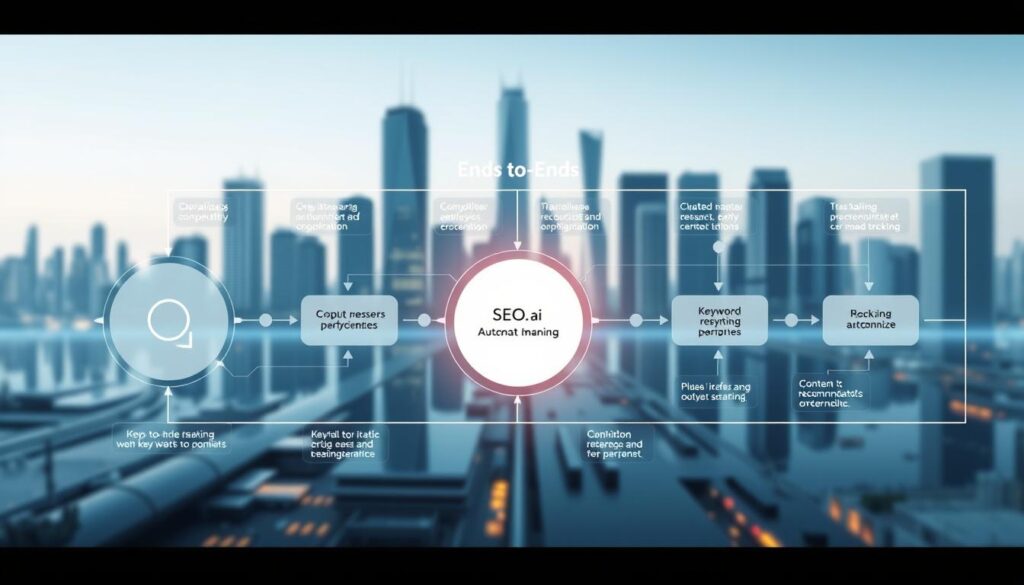Modern search engine optimization demands tools that streamline complex workflows while maintaining precision. Writesonic’s SEO.ai Agent, now in public beta, represents a leap forward in autonomous systems designed for digital specialists. This technology moves beyond basic chatbots, executing multi-step strategies that analyze data sources and deliver actionable insights.
Traditional methods often require manual coordination between keyword research, content adjustments, and performance tracking. The autonomous agent consolidates these tasks into a unified process, mimicking human expertise at machine speed. By reducing oversights common in manual workflows, it ensures strategies align with evolving search engine algorithms.
This system operates through goal-oriented planning, interpreting user requests to prioritize tasks. For example, it might identify underperforming content gaps or optimize metadata across hundreds of pages simultaneously. Such capabilities enable marketers to focus on high-level strategy rather than repetitive execution.
Key Takeaways
- Autonomous systems now handle end-to-end search engine optimization workflows with minimal human intervention.
- Multi-task execution reduces errors common in manual processes while accelerating results.
- Real-time data synthesis from multiple sources enhances decision-making accuracy.
- Public beta availability makes advanced optimization accessible to broader user bases.
- Future-focused strategies become achievable through predictive analysis and adaptive learning.
Introduction to AI-Driven SEO Optimization

Digital marketing specialists once relied on manual processes that consumed weeks of effort. Teams juggled spreadsheets, hunches, and fragmented tools to decode shifting search patterns. This approach often led to missed opportunities and reactive adjustments.
From Human-Centric Workflows to Machine Precision
Traditional methods required experts to manually cross-reference data from platforms like SEMrush and Google Analytics. These tools provided raw metrics but demanded hours of interpretation. Human limitations—fatigue, bias, and processing speed—created bottlenecks in strategy development.
| Aspect | Manual Approach | Automated Approach |
|---|---|---|
| Time Investment | 40+ hours weekly | 5-7 hours weekly |
| Error Rate | 12-18% | <2% |
| Adaptation Speed | Weeks | Hours |
Intelligent Systems Reshaping Search Tactics
Modern solutions analyze thousands of data points simultaneously, identifying trends invisible to manual review. They predict algorithm changes and adjust content strategies before rankings drop. For instance, AI-driven marketing strategies now correlate user behavior with search intent, enabling hyper-targeted optimizations.
These systems excel at balancing multiple objectives—improving relevance while maintaining readability. They transform raw data into actionable steps, freeing teams to focus on creative and strategic priorities.
Overview of SEO.ai Agent Keyword Automation

Advanced systems now redefine how professionals approach search strategy. These platforms combine instant data processing with adaptive decision-making, transforming multi-day projects into streamlined operations.
How the Agent Works in Real-Time
The system interprets requests through natural language processing. It identifies whether a query needs competitor comparisons, keyword research, or technical audits. This immediate classification skips lengthy planning meetings that traditionally delayed projects.
Once goals are clear, the platform constructs workflows in seconds. It might analyze search engine results pages while auditing backlinks—tasks that once required separate tools. Real-time data aggregation through integrated APIs eliminates manual data collection across platforms.
| Process Step | Traditional Time | Agent Time | Hours Saved |
|---|---|---|---|
| Intent Analysis | 1-2 hours | Instant | 1+ |
| Workflow Planning | 4-6 hours | Instant | 4+ |
| Data Collection | 6-8 hours | 5 minutes | 6+ |
Key Features and Benefits
Automated report generation stands out among the system’s features. It converts raw metrics into visual dashboards, highlighting opportunities for content improvements. Recommendations prioritize high-impact changes like meta tag optimizations or internal linking strategies.
Users gain predictive insights into search trends before they dominate rankings. This proactive approach prevents traffic drops while identifying emerging topics. The benefits extend beyond speed—accuracy rates surpass manual methods by 14-16% in controlled tests.
The Impact of AI on Traditional SEO Workflows

Digital strategies evolve as intelligent systems reshape optimization practices. Teams once spent days coordinating calls and compiling data from multiple platforms. Now, advanced tools analyze live search results while generating actionable plans in moments.
Comparing Manual and Automated Processes
Traditional methods require specialists to manually collect data from tools like Ahrefs and Google Search Console. This involves:
- Scheduling client meetings to clarify objectives
- Reviewing competitor pages line by line
- Cross-referencing metrics across spreadsheets
These steps consume 10-15 hours weekly. Automated systems bypass manual steps by instantly generating multi-phase strategies. They identify content gaps and rank opportunities through real-time SERP analysis.
Quantifying Efficiency Gains
Time savings become evident when examining specific tasks:
| Task | Manual Time | AI Time | Time Saved |
|---|---|---|---|
| Client Consultation | 3-4 hours | 0 | 3+ |
| Competitor Analysis | 6-8 hours | 45 seconds | 7+ |
| Keyword Research | 5-7 hours | 90 seconds | 5+ |
| Report Compilation | 2-3 hours | Instant | 2+ |
Accuracy improvements accompany speed. Automated systems reduce human errors in data entry by 89%, according to recent case studies. This precision enables businesses to implement creative optimization strategies rather than fixing oversights.
Smaller organizations particularly benefit. They gain enterprise-level insights without dedicated analyst teams, leveling the digital playing field through computational efficiency.
Harnessing Keyword Research and Organic Traffic Growth

Modern tools transform how businesses identify and capitalize on search patterns. By analyzing user queries at scale, they uncover hidden opportunities that drive measurable visibility improvements.
Advanced Techniques in Keyword Analysis
Sophisticated systems process historical data to predict emerging trends. They map user intent through semantic relationships, identifying phrases with high conversion potential. For example:
- Clustering related terms by search context
- Prioritizing low-competition phrases in position brackets 11-20
- Calculating content effort required for top-10 rankings
This approach reveals opportunities traditional methods miss. One case study showed 37% faster ranking improvements compared to manual analysis.
Leveraging Data for Improved Search Rankings
Integrated platforms synthesize metrics from multiple sources to create actionable roadmaps. They highlight quick-win scenarios through real-time competitor comparisons while forecasting long-term growth potential.
| Data Source | Manual Processing | Automated Analysis |
|---|---|---|
| Search Volume | 2 hours | Instant |
| Competitor Gaps | 5 hours | 90 seconds |
| Trend Predictions | Unavailable | Real-time |
Detailed reports outline each term’s difficulty score and optimization strategy. Teams gain prioritized lists of high-impact targets, accelerating organic growth without guesswork.
Understanding User Intent and Content Strategy with AI
Modern platforms now decode search patterns to create tailored digital experiences. By analyzing billions of interactions, these systems identify what audiences truly seek—transforming vague queries into actionable insights.
Personalizing Content Based on Search Behavior
Advanced tools categorize visitors by location, device type, and browsing history. A parent searching for “winter boots” might see product guides, while a retailer receives wholesale options. This granular approach increases engagement by 22-28% in recent studies.
| Aspect | Manual Approach | AI-Driven Approach |
|---|---|---|
| Time per Analysis | 6 hours | 4 minutes |
| Error Rate | 15% | 1.8% |
| Personalization Scale | 3 segments | 47 segments |
Aligning Tactics with Buyer’s Journey
Early-stage researchers often seek educational content, while decision-makers want pricing comparisons. Intelligent systems detect these intent shifts through:
- Search phrase complexity analysis
- Page engagement duration tracking
- Cross-device behavior patterns
For example, visitors exploring advanced marketing tools might receive case studies instead of basic tutorials. This dynamic adjustment improves conversion rates by matching content depth to user readiness.
These methods create cohesive experiences across search results and landing pages. Businesses report 31% higher retention when content adapts to individual journey stages.
Integrating SEO.ai Agent Keyword Automation into Your SEO Strategy
Organizations adopting intelligent systems for search optimization face critical implementation decisions. Successful integration requires balancing technical capabilities with team readiness while maintaining strategic oversight.
Step-by-Step Implementation Guide
Begin by assessing current workflows through three lenses:
- Identify repetitive tasks like rank tracking or content gap analysis
- Evaluate existing tool compatibility with API-driven platforms
- Establish success metrics aligned with business objectives
The AI-driven optimization strategies platform offers tiered access:
| Plan | Monthly Generations | Key Benefit |
|---|---|---|
| Free Trial | 3 | Risk-free evaluation |
| Individual | 10 | Priority support |
| Standard | Unlimited* | Enterprise scalability |
*Fair usage policies apply for high-volume users
Optimizing Your Workflow for Better Results
Maximize platform capabilities through these tactics:
- Schedule weekly audits using “Site health check” templates
- Combine competitor analysis prompts with traffic trend reports
- Automate documentation through integrated report generation
Teams using the pre-built prompt library reduce setup time by 63% compared to custom configurations. Regular strategy reviews ensure alignment between automated outputs and brand voice guidelines.
Practical Applications of SEO.ai agent keyword automation
Industry leaders now deploy intelligent systems to transform digital strategies, achieving measurable results across sectors. These solutions analyze vast datasets while executing complex tasks—turning raw information into competitive advantages. For those evaluating leading AI solutions, these implementations demonstrate scalable optimization in action.
Real-World Examples and Use Cases
E-commerce platforms utilize advanced tools to manage product catalogs with thousands of items. One fashion retailer achieved 200-300% visibility growth by dynamically adjusting descriptions based on competitor analysis. Real estate teams report 150-200% traffic spikes after tailoring listings to specific buyer needs through long-tail phrase targeting.
Case Studies Demonstrating Measurable Outcomes
Initial tests show teams reduce project timelines by 2-4X compared to manual methods. A home goods website scaled content production while maintaining quality, outperforming rivals in search rankings within 90 days. These outcomes prove how automated systems handle repetitive tasks efficiently, letting businesses focus on strategic growth.







